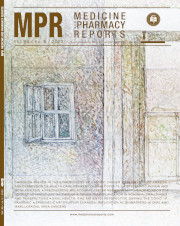Influence of the learning curve on the immediate postoperative pain intensity after laparoscopic inguinal hernioplasty
DOI:
https://doi.org/10.15386/mpr-2525Keywords:
inguinal hernia, TAPP procedure, self-griping surgical mesh, postoperative painAbstract
Introduction. Inguinal hernia repairs represent one of the most commonly performed surgical operations worldwide. As more experience has been gained over the past decades with laparoscopic techniques, they are now widely used also for the repair of primary and unilateral inguinal hernias, representing a safe and effective alternative. One of the major concerns of patients undergoing inguinal hernia repair is postoperative pain and socio-professional reintegration.
Aim of study. This study started from the hypothesis that the learning curve could influence postoperative pain intensity after laparoscopic inguinal hernioplasty.
Methods. A retrospective - comparative study was performed, including a general surgeon’s first consecutive cases (n=87) of TAPP (transabdominal preperitoneal procedure) hernioplasty procedures with implantation of self-gripping surgical prosthesis were investigated.
Results. The evaluation of clinical and surgical aspects resulted in similar values in case of the studied groups. A reduction in surgical time was observed in case of patients operated after completing the learning curve (p = 0.0005) On the first postoperative day patients complained mostly about persistent and severe type of pain. Average Pain Index calculated with help of Simple Numeric Pain Scale resulted in similar values. Length of analgesic treatment showed no significant differences. Although higher intensity pain was mostly caracteristic in case of patients operated during the learning process, no significant relationship between learning curve and postoperative pain intensity were highlited.
Conclusion. TAPP can be a safe technique for young surgeons as well, with the right study program the procedure can be mastered safely.
Downloads
Published
How to Cite
Issue
Section
License
The authors are required to transfer the copyright of the published paper to the journal. This is done by agreeing to sign the Copyright Assignment Form. Whenever the case, authors are also required to send permissions to reproduce material (such as illustrations) from the copyright holder.

The papers published in the journal are licensed under a Creative Commons Attribution-NonCommercial-NoDerivatives 4.0 International License.

